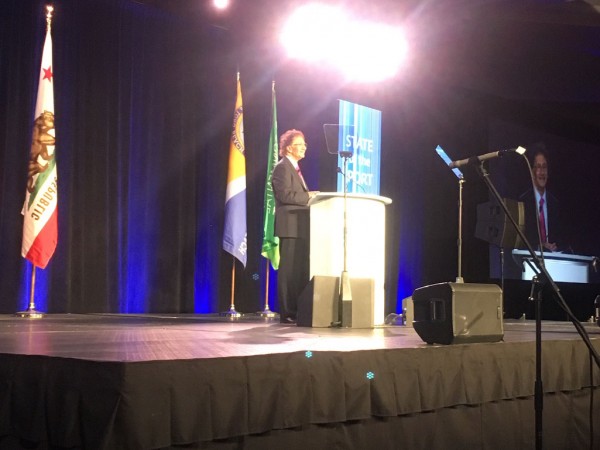Mario Cordero, executive director of the Port of Long Beach, says the Port’s $4 billion capital improvement investment is “paying off.”
Investment Pays Off
The growth of the North Asia to Europe trade means that bigger ships are continuing to push out smaller ships and as they do we are seeing bigger and bigger ships at the Port.
Thanks to the investment in automated cargo-handling at Long Beach Container Terminal, the Port is well-positioned to handle these larger-sized vessels.
Cordero explained: “The Port is in the process of completing a $4 billion infrastructure and capital improvement plan to make the Port even more competitive in coming years.”

He noted:
The automated Long Beach Container Terminal should be fully built-out in 2020. This will allow the Port to handle 18,000 twenty-foot unit and larger container ships.
A reflection of the capital investment strategy is that in 2018, two Long Beach terminals have had the best turn times for trucks entering and leaving the Port among the Long Beach/Los Angeles container terminals. They were the Long Beach Container Terminal and the Matson Terminal.
The investment improves productivity and profitability for Port operations. This reduces costs for the Port, whose finances Cordero described as “real good.” Revenues are primarily dependent on the growth of container imports and exports.
The new replacement of the Desmond Bridge “will be open for two-way traffic by the end of 2019. This will be the second highest cable-stayed (cable-suspended) bridge in the United States. It is an iconic bridge which will help boost the image of the City of Long Beach.” It will also speed up harbor truck traffic within the Port and between the Long Beach and Los Angeles ports, which adjoin each other.
The old Desmond bridge’s demolition will begin in 2020.
Trade with China
Cordero worries about the lack of resolution in the U.S.-China trade dispute, because “uncertainty is not a good business environment.”
He is hopeful that the two countries will resolve their differences in 2019, but says the Port still expects to grow this but probably not at the record levels set in 2017 and 2018: “While I remain optimistic about our growth in 2019, we have had two excellent years at this port complex.”
Record Year
Cordero said the Port had a record-breaking year: “We handled 8 million containers at the Port in 2018 exceeding the record growth in container volume we set in 2017.”
PierPass
The PierPass program succeeded at reducing the number of day time truck deliveries at the Long Beach and Los Angeles ports by imposing a per container fee on day time deliveries.
The result was reduced day time traffic on the 710 freeway and other freeways linking to the two ports.
Last November, the Federal Maritime Commission cleared PierPass to launch its revised OffPeak program of extended gate hours at the Ports of Los Angeles and Long Beach, according to an announcement on the PierPass website.
The revised OffPeak program, informally called PierPass 2.0, replaces the original OffPeak congestion-pricing model with a system using appointments to mitigate traffic. It uses a reduced Traffic Mitigation Fee (TMF) across all hours of terminal operation to help offset the cost of operating extended gates.
As previously announced, the current TMF of $72.09 per TEU (twenty-foot equivalent unit) will be reduced to $31.52 per TEU or $63.04 for all other size containers. The TMF will be charged during all shifts on all days.
PierPass set up the OffPeak program in 2005 to relieve severe congestion in and around the ports. It established new night and Saturday shifts during which trucks can move cargo containers to and from the terminals. The new changes to the OffPeak program are being made in response to requests from port users, who seek increased flexibility and a reduction in the bunching up of trucks that often occurs before the start of the nighttime OffPeak shifts.
Cordero noted that there has been sufficient progress as well as protests by shippers and carriers about the high per container fee to revise the previous program and replace it with PierPass 2.0.
PierPass Inc. is a not-for-profit company created by marine terminal operators at the Port of Long Beach and the Port of Los Angeles to address “multi-terminal issues such as congestion, air quality and security.”
Clean Air Action Plan
The Ports of Long Beach and Los Angeles are collaborating in the Clean Air Action Plan so as to reduce operations at the two ports to zero emissions. The CAAP goals are to ensure that 1) cargo-handling at the two Ports generates zero emissions by 2030 and 2) truck transportation be zero emission by 2035.
“When we got started many people questioned whether the zero-emission equipment was there. Today, I am pleased to say that the equipment is beginning to show up. Some may not be market ready and so we have received a $50 million grant from the California Air Resources Board for investment in new zero emission technology, which includes electric powered top loaders (for container handling) and electric powered trucks.”
Cordero says this and other grants help port terminal operators and trucking companies begin the process of moving over to electric and battery powered equipment so as to meet zero emission goals in 2030 and 2035.
Cordero says the grant program also features investments at the Port of Oakland and the Port of Stockton to help other California ports meet zero emission goals.

